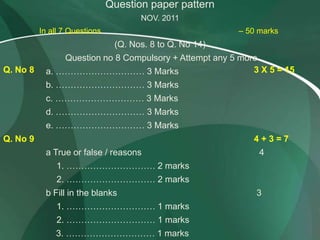Here are short notes on the Economic Environment:
(a) Rates: Interest rates, inflation rates, exchange rates which impact costs and demand.
(b) GDP Aspects: GDP growth rate, per capita income, income distribution which indicate market potential.
(c) Customer related: Disposable income, spending patterns, debt levels affect demand for products/services.
(d) External Trade: Export/import policies, trade barriers, trade agreements affect competitiveness.
(e) General: Economic conditions, economic policies, business cycles influence overall business environment.
The economic environment analysis helps understand market opportunities and threats from macroeconomic forces. It is important for effective strategic planning and decision making






































![34
Q. What are the reasons for Globalization ? [or]
What are the advantages of Globalization ?
1. Rapid shrinking of time and distance
2. Global Market
3. Cheaper source of Raw Materials
4. Foreign investment
5. Lower Transportation Costs
6. Global Technology
7. Increasing emphasis
8. The rise of service - oriented](https://image.slidesharecdn.com/chapter1businessenvironment-121227114934-phpapp02/85/Chapter-1-business-environment-39-320.jpg)



![(2) Potential entry of new competitors 40
Intensity of competition increases when
a) Ind. Attractiveness increases
(e.g. 1. cellular phones
b) When new entrants appear 2. shopping malls)
What Prevents Competitors ?
1) Technology [ Barriers to entry]
2) Economies of scale
3) Experiences
4) Customer loyalty
5) Brand image
6) Huge capital
7) Distribution channels
8) Raw materials
9) Potential Saturation of Market
Rule : - Strategists have to watch out for new entrants and their strategies
that we can make counter attacks.](https://image.slidesharecdn.com/chapter1businessenvironment-121227114934-phpapp02/85/Chapter-1-business-environment-43-320.jpg)




